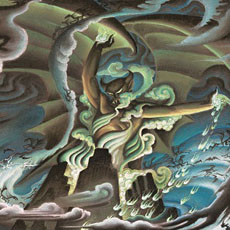Walt Disney Pictures (January 1, 2000), Walt Disney Video (November 14, 2000), single disc, 74 mins plus supplements, 1.85:1 aspect ratio, Dolby Digital 5.1 Surround Sound, Rated G, Retail: $29.99
Storyboard:
When Walt Disney released the original Fantasia in 1940, he envisioned a cartoon that would introduce the general public to classical music. The original included seven different musical sequences (“Toccata and Fugue in D Minor”, “The Nutcracker Suite”, “The Sorcerer’s Apprentice”, “The Rite of Spring”, “Pastoral Symphony”, “Dance of the Hours”, and “Night on Bald Mountain” with “Ave Maria”). It was Disney’s most ambitious film yet (his third), following the successes of Snow White and the Seven Dwarfs and Pinocchio. At the time, Disney had been developing Mickey’s “The Sorcerer’s Apprentice”, and he met with conductor Leopold Stokowski to conduct the score. The story goes that Stokowski proposed an expansion of the idea to make a feature filled with many different musical themes. Disney then agreed to the idea and Fantasia was set into motion. The movie opened to mixed reviews as many thought that setting music to animation was near sacrilege. Financially, the movie did not do as expected since many people felt the movie, with its classical music, was for intellectuals.
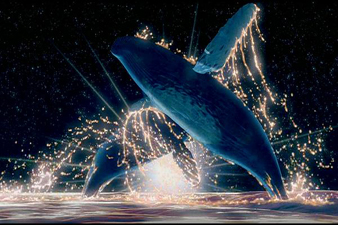
Plans to have Fantasia in perpetual release with new segments added throughout the years were cancelled. Many of the segments already being discussed at the studios were either cancelled or released in other features. The “Clair de Lune” sequence (with different music), originally intended to come out in Fantasia, was later inserted into Make Mine Music under the name “Blue Bayou”. Peter and the Wolf, a sequence planned to insert into Fantasia in the later years, would also come out in Make Mine Music. Other segments never came to pass such as “Invitation to the Waltz”, “Humoresque”, “Swan of Tuonela”, and “Ride of the Valkyries”. Like many Disney features, Fantasia had several re-releases, but it was only in the 1970s that the movie became popular for the visual imagination that became popular at the time. In 1990, in its fiftieth anniversary, the movie was released and became a hit. The video that followed was one of Disney’s most successful. The stage was set for a rebirth of Fantasia.
A new Fantasia has been discussed in the 1980s by Jeffrey Katzenberg (rumor is that in his version the music used would be from the Beatles). Finally, Roy E. Disney decided to head the project and set it into motion. Fantasia 2000 was finally released in IMAX theatres worldwide on January 1st 2000 after a series of live multimedia performances held around the world (New York City, London, Paris, Tokyo and Los Angeles). The IMAX experience really made it into an event for those in the audience. The DVD edition is still an experience and those who did not see it on IMAX one can only imagine what it looked like on the very big screen.
The Sweatbox Review:
For Fantasia 2000, Roy Disney and producer Don Ernst chose James Levine, of the Chicago Symphony Orchestra, to be the conductor. Roy Disney found in Levine a person who was eager to undertake the task of animating excerpts of classical pieces. The Orchestra plays the music to the eight sequences in the movie. Included in this new version is the Mickey Mouse sequence, “The Sorcerer’s Apprentice”, from the original film. The sequences are introduces by many popular actors and personalities. These include Steve Martin, Itzhak Perlman, Quincy Jones, Bette Midler, James Earl Jones, Penn & Teller, James Levine, and Angela Lansbury. Like the original Fantasia, Mickey also makes a brief appearance after “The Sorcerer’s Apprentice”. First they show the original sequence when Mickey congratulates Stokowsky and then Mickey (now voiced by Wayne Allwine) goes to Levine to tell him that they cannot find Donald to give him his cue. Each piece is individual and spectacular in its own way and they all combine to make a great feature.
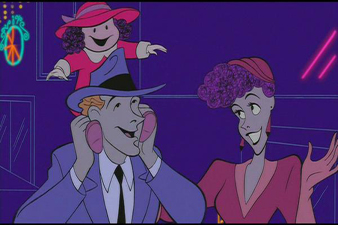
The DVD starts out with an introduction by Roy Disney talking about Fantasia and the legacy that it left in the Disney Studios. He also talks about the technical innovations that Fantasia and later films brought to enhance the art of animation. After the introduction and opening titles, where we see the orchestra set in outer space, the feature begins. The very first sequence is Beethoven’s “Symphony No. 5.” The sequence features abstract drawings with vibrant colors. As the music rises, we get involved in the story of two colorful butterflies trying to escape a flock of darker butterflies. With Beethoven’s powerful music, which is one of his most known pieces, we are instantly captivated by the animation which enhances emotions through its use of color. Then, Steve Martin comes out to introduce Itzhak Perlman. Martin’s introduction is comical, yet classy, and it reminds us that music is something that is fun and not something just for the sophisticated.
Itzhak Perlman introduces one of the best sequences in the feature, which is “Pines of Rome.” This was one of the first sequences, first suggested by Roy, made for Fantasia and it is about flying whales. Apparently, when the animators heard the piece they envisioned something flying. Someone drew cloud shapes during a meeting and one of the clouds was shaped like a whale. This led to a grand piece set in the cold waters under the aurora borealis. The story is about two whales and their calf. After soaring across the night sky, the small whale gets separated from its parents. It follows his extraordinary journey and ends with a most spectacular finale. This sequence is the most original sequence in the feature and the animation is incredible.
The second sequence, “Rhapsody in Blue” by George Gershwin, is directed by Eric Goldberg. Goldberg’s wife Susan was the art director and they began making the sequence independently of Fantasia. They decided to use the design and look of the great caricaturist Al Hirschfeld. Hirschfeld’s drawings, combined with Gershwin’s music is reminiscent the style of UPA cartoons of the 50s. There are several stories in the sequence including those of a man who wants to be in a jazz band, an unemployed worker, a lonely little girl, and an old rich couple. The sequence is probably the best sequence in the feature because it does not try to impress the audience visually (although the animation is incredible), but the use of music with the animation is what sets it apart. It deals with people’s dreams and desires and it is touching to see such a great jazz piece make its way to Fantasia.
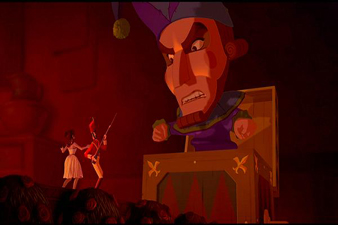
Hans Christian Andersen’s “The Steadfast Tin Soldier” was a project that sat in development at Disney for years. This next piece came to be when Roy was leafing through the book, and listening to Shostakovich’s “Piano Concerto No. 2, Allegro, Opus 102” at the same time. He put two and two together and the sequence was formed. The computer animated sequence is very intense and colorful. The story follows a one-legged tin soldier who defends a ballerina from harassment by a jack-in-the-box. . It probably is one of the fanciest sequences in the feature, and the intensity of the animation and backgrounds resemble a storybook. While not the best sequence, it still has its great musical moments when the tin soldier is fighting off danger in the form of rats and the jack-in-the-box.
The animation of “Carnival of the Animals, Finale” was the idea of Joe Grant, who had worked on the original Fantasia. He had the idea of the ostriches from “Dance of the Hours” playing with a yo-yo. The ostriches became flamingoes and the sequence follows a group of flamingoes going about their daily life. However, when one flamingo gets a hold of a yo-yo and begins to play with it, the others want him to get in line and join their dance. In a classic clash of personalities, this sequence is the most humorous sequence with many visual gags as the flamingoes are trying to get rid of their friend’s yo-yo. The flamingoes make a great subject and they are fun to watch. The animation, with very simple backgrounds, is very colorful and pink. Combined with the music, this sequence is one that remains in the mind a long time after it is over.
The next sequence is the restored original “The Sorcerer’s Apprentice” featuring Mickey Mouse. Roy talks about how they had originally had “Dance of the Hours”, “The Nutcracker Suite”, and “The Sorcerer’s Apprentice” in Fantasia 2000. Finally, they dropped the other two and only “The Sorcerer’s Apprentice” remained, and rightfully so. This is one of the most memorable Mickey Mouse performances ever and it has always been one of the key sequences of Fantasia. The sequence is the one when Mickey gets a hold of his master, the Sorcerer’s, hat which he uses to enchant a broom to do his chores. The sequence is followed by Mickey congratulating Stokowsky, from the original, and then going to Levine to congratulate him. Mickey then tells Levine to stall until he can find Donald for the next sequence.

Sir Edward Elgar’s “Pomp and Circumstance” is best known as the song they play at graduations. Suggested by Michael Eisner after attending a graduation, this classic marching song was chosen to follow the story of Noah’s Ark. Here, Donald Duck is Noah’s helper trying to get the different pairs of animals into the ark. Daisy also stars in this short and the two enter the ark thinking that the other one missed it. It is the most heartwarming sequence and it is funny to see Donald and Daisy consistently miss each other in the ark. There are several interesting ideas and gags such as a group formed by dragons and a unicorn laughing at the animals as they enter the ark and Donald being dumbfounded when leading two ducks into the ark. I found it interesting that the musicians managed to make the performance to such a known piece of music unique. The result is will probably become one of the most memorable Donald ever cartoons created.
Stravinsky’s “Firebird Suite – 1919” is the last sequence in the feature. The sequence is about birth, death and renewal. A deer is walking through a cold forest and encounters a spring. When he touches the spring, a green spirit emerges bringing life back into the forest, making everything green once again. The spirit then faces the wrath of a volcano that erupts destroying the forest underneath. With inspiring animation, this sequence reminds the viewer of the feelings felt after seeing “Night on Bald Mountain” with “Ave Maria” from the original. The mythical story is beautiful rising with Stravinsky’s music in the grand finale. It has a great impact and ends the feature on a hopeful note.
Is This Thing Loaded?
The DVD includes many great special features. First, it includes informative audio commentaries by executive producer Roy E. Disney, conductor James Levine, and producer Don Ernst. Another audio track features the commentary from the segment and art directors. The audio commentaries are interesting for those that want to know how the segments developed and how Fantasia 2000 was born. You can also see many of these comments in the “Making of Fantasia 2000” featurette. This follows the history of Fantasia, and the story behind all of the sequences, ending with the IMAX experience. There is also a showcase program that features clips from the various sequences in Fantasia 2000.
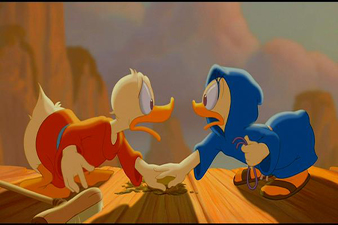
The DVD also includes two animated shorts relating to music. These are Melody and Toot, Whistle, Plunk, and Boom, which won the Academy Award for 1953. You may remember many of these sequences if you have ever seen Disney’s Sing-along videos. These stories follow an owl teaching his students about the history of music and harmony. Toot, Whistle, Plunk, and Boom is the better of the two, but Melody does have its good moments. Both shorts fit well in this DVD and they are a great addition to musical collection.
Case Study:
This release is being released in a standard black keepcase. The cover features beautiful images from the film. Inside is an insert for individual chapters.
Ink And Paint:
With a digital-to-digital transfer, Fantasia 2000 looks amazing. The animation is colorful and extraordinary. Every single piece is animated to make it look good on the big IMAX screen so even the details are there. It is in the 1.85:1 anamorphic widescreen aspect ratio, except for “The Sorcerer’s Apprentice.” The image is clear and free of grains since it came from the digital source. They did some cleanup in “The Sorcerer’s Apprentice” segment, but there are still many visible grains common in sixty-plus year-old films. Overall, Fantasia 2000 does not disappoint those who buy DVDs for the image quality available.
Scratch Tracks:
Disney has gone out of its way to make this one of the best sounding releases they have come out with. It is available in DTS 5.1 Surround Sound, Dolby Digital 5.1 Surround Sound, as well as a 5.1 French track. The music sounds great and the quality makes it really feel like you are in a concert hall. The DVD comes with two different commentaries, which are discussed below. It also comes with English and French captions.

Final Cut:
I have to confess I did not expect much from this release. When I first saw Fantasia, I was only mildly impressed (it has been a long time and I wish to see it again). However, I was blown away by this feature. The music that they have selected for the different segments successfully combines with the animation. The feature is a great blend between abstract, serious, and humorous animation. I am very glad that they had a segment with Donald and that they left “The Sorcerer’s Apprentice” from the original. The special features that they added were also very good and made this a great addition to any collection.
 | ||
 |










